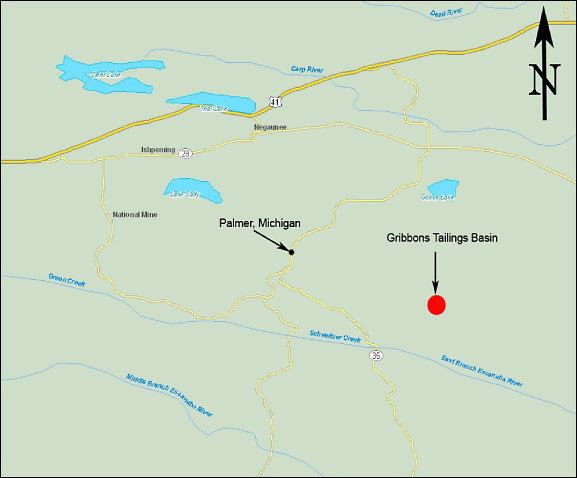Case Study as part of a Web-based
Technical and Regulatory Guidance
Gribbons Basin Site
Marquette County, Michigan
1. Site Information
1.1 Contacts
Richard Aho
Telephone: 906-249-4125, ext. 26
E-mail: [email protected]
1.2 Name, Location,
and Description
The Gribbons Tailings Basin is
a tailing basin and waste rock pile from open-pit iron mining. The
site receives waste from Empire and Tilden mining facilities in the
Marquette Iron Range near the town of Palmer, Michigan (Figure 1-1).
The Empire Mine has operated since 1963, while the Tilden Mine began
operations in 1974.

Figure 1-1. Gribbons Tailings Basin location map. Created with ArcGIS Desktop Version 9.3.1.
The water used for processing the iron-bearing material through the concentrating process also carries the tailings to a large impoundment called the Gribbons Tailings Basin. The water is decanted and clarified so it can be returned to the watershed meeting all government clean water standards.
The Gribbons North Basin tailings disposal system consists of 14 tailings discharge points, a tailings beach, a water pond, a decant structure/surface water discharge system, and a 22,500-ft dike system. Tailings are added to the basin at a rate of approximately 12 million long tons per year. The construction of the Gribbons South Basin expansion doubles the size of the tailings disposal system, adding nine tailings discharge points, a second tailings beach, water pond and decant structure/surface water discharge system, and a second 25,500-ft dike system.
The affected media associated with this site are soil and surface water with fugitive dust being the primary concern. The overall goals of the remedial actions are the minimization of erosion and protection of water resources. The site cleanup goals are based on this mitigation of ecological risk.
2. Remedial Action and Technologies
The site is regulated under the Surface Mining Control and Reclamation Act
(SMCRA). However, the facility is active, and site reclamation is not required
until closure. Currently, composted municipal solid waste (MSW) and paper
mill sludge are applied to the tailings to supply organic matter and establish
vegetation. The goal is to establish cost-effective reclamation to minimize
long-term liability.
3. Performance
Effectiveness of the caps and covers are evaluated with regular water sampling.
The sludge application is active but has developed selenium issues. Composted
MSW application is a proposed project that has pending regulatory review.
4. Costs
The primary cost associated with the remediation at this site is for the
operation and maintenance: $0.50/yd2 of surface. Transportation of materials
to the site is the primary expense; application varies with materials. Materials
are processed waste being put to beneficial use.
5. Regulatory
Challenges
There are regulatory issues associated with this new technology since Michigan
currently has no standards for the use of composted solid waste.
6. Stakeholder
Challenges
None reported.
7. Other Challenges and Lessons
Learned
The need for communication regarding project goals and standards is absolutely
critical. The interpretation of test results and the scope of testing must
be clearly defined and embraced by the regulatory agency, the mine operator,
and the material supplier. The use of former waste products reduces cost
but requires a higher level of monitoring of incoming materials and site
dynamics.
8. References
Milner, M. P., General Manager, Tilden Mining Company L.C. 1998. Letter.
to W. A. Dellies, Air Quality Division, Michigan Department of Environmental
Quality. “Subject: Tilden Mining Company L.C. Dust Abatement Program."
